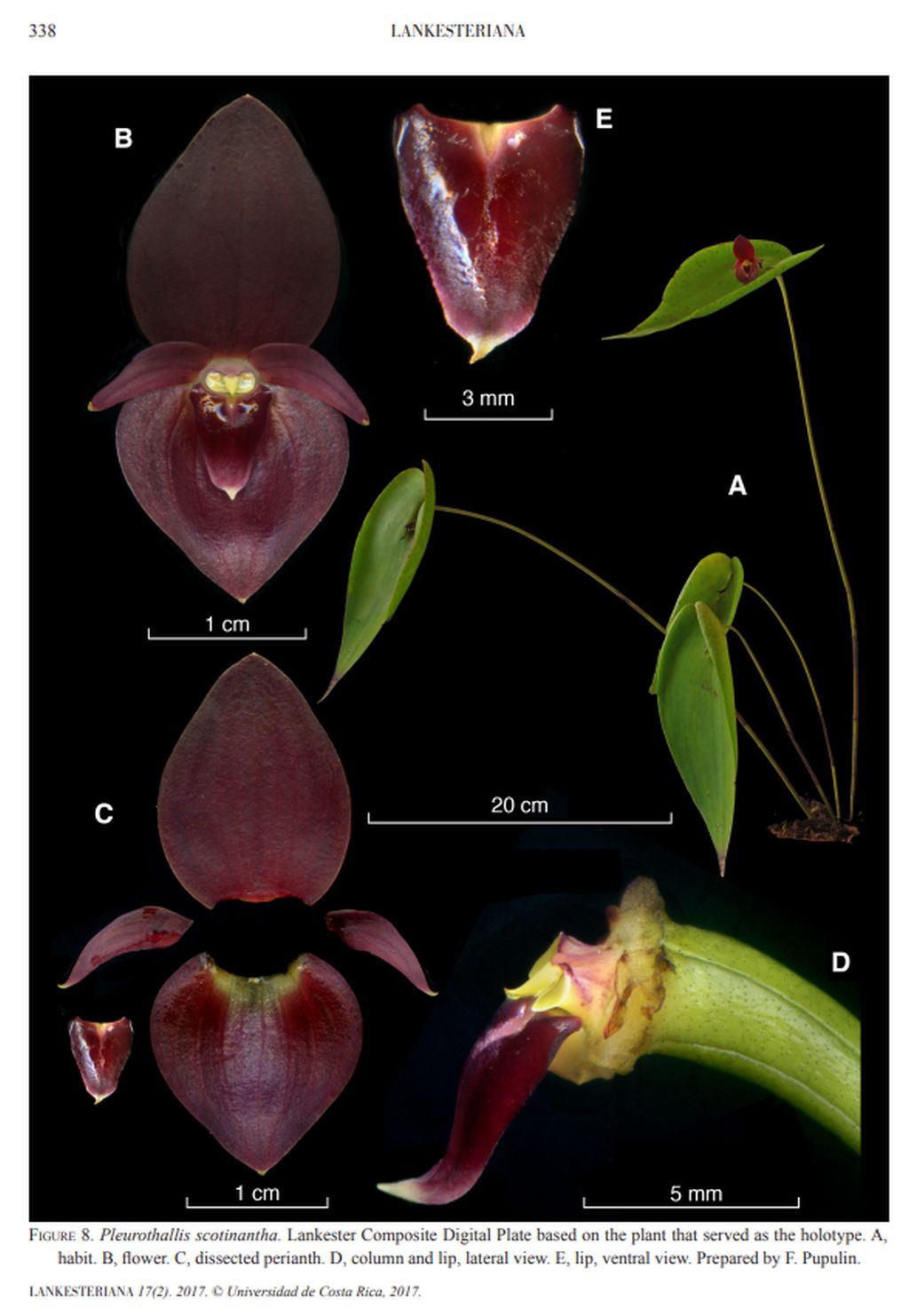

Pleurothallis scotinantha Pupulin, M.Díaz & J.Aguilar 2017 SUBGENUS Pleurothallis SECTION Macrophyllae-Fasciculatae Lindl 1859
Photo/TYPE Drawing by Pupulin & Darha Solano Ulate
Comparison photo between lips P scotiantha and P oncoglossa
Photo/by Franco Pupulin






Common Name The Dark Pleurothallis [Refers to the deep purple color of the flower]
Flower Size 1" [2.5 cm]
Found in Costa Rica on the Cordillera Central and Cordillera de Talamanca on the Pacific watershed in wet premontane and lower montane forest, at mid-elevations of 1200 to 2000 meters as a medium sized, cool growing epiphyte with erect, terete, yellowish green ramicauls provided with a tubular, short, truncate glumaceous, pale green when young, becoming brown, dry-papyraceous with age sheath at the base, and a longer, tubular, tightly adpressed, truncate,glumaceous, pale green when young, becoming brown, dry-papyraceous with age sheath below the middle, and carrying a single, apical, borne horizontally at the apex of the ramicaul, becoming subpendent with age, thinly coriaceous, flexible, ovate, acute to acuminate, deeply cordate, forming two slightly imbricate lobes at the base, grass green, matte, sessile base leaf that blooms at most any time of the year on a solitary flower, usually produced singly, rarely in pairs, from a reclined, brown, dry-papyraceous when mature, eventually dissolving with age spathaceous bract,
"Lacking univocal information about the origin of P. cardiothallis, the view that the distribution of the species spans from southern Mexico, over the entire Central American isthmus, to the northern portion of the Andes in South America, has prevailed in taxonomic literature. Inevitably, this interpretation lead to a concept of P. cardiothallis as a “variable species”, reducing under this name most of the observed morphological variation in large Pleurothallis plants of the Macrophyllae-Fasciculatae group. This is not, however, what we find in Costa Rican populations, which present discrete and recognizable variations throughout the sampled individuals. Whilst the lip of P. cardiothallis is unequivocally shield-shaped in outline, the lip of P. scotinantha is triangular, more similar in general shape to that of P. oncoglossa. As well as in P. oncoglossa, the flower is fully spread at the peak of anthesis, and the sepals do not reflex backwards as in P. cardiothallis. The dark purple, blackish, glossy color of the flower, the triangular, flat, dark purple lip fading into a small white region towards the apex, whitish on the underside, are useful characters to distinguish it from its closest relative, P. oncoglossa, which has light purple-red flowers on a greenish yellow background, the sepals fading yellow-green toward the base, and a characteris-tic, callose hook at the apex of the lip." Pupulin 2017
Synonyms
References W3 Tropicos, Kew Monocot list , IPNI ;
* LANKESTERIANA 17(2): 337 Pupulin 2017 photo/drawing fide;
Vanishing Beauty, Native Costa Rican Orchids Vol 2 Lacaena to Pteroglossa Pupulin 2020 photo fide;
Harvard Papers in Botany Vol. 26, No. 1 2021, The Researchgate Website photo/drawing fide;
--------------------------------------------------------------------------------------------------------------------------